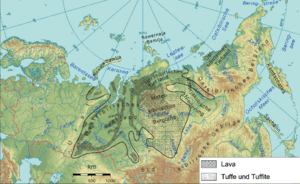Siberian Traps facts for kids
The Siberian Traps are a massive area of volcanic rock in Siberia, Russia. Think of it as a huge region where ancient volcanoes erupted a lot of lava!
These giant eruptions were some of the biggest volcanic events on Earth in the last 500 million years. They lasted for about a million years, around 251 to 250 million years ago. This was a very important time because it happened at the same time as the Permian–Triassic extinction event. This event, also called the "Great Dying," wiped out about 90% of all living things on Earth! Scientists think the Siberian Traps eruptions might have caused this terrible event.
The word "traps" comes from the Swedish word trappa, which means "stairs." This is because the landscape in this area looks like steps or stairs, which is common for places where a lot of lava has flowed out.
Contents
Where are the Siberian Traps?
Long ago, huge amounts of lava flowed out and covered a massive part of ancient Siberia. Today, this area is about 2 million square kilometers. That's roughly the size of Western Europe! Some scientists think the original lava flows might have covered up to 7 million square kilometers. The amount of lava that erupted was also enormous, possibly between 1 and 4 million cubic kilometers. Imagine that much rock!
How did the Siberian Traps form?
Scientists believe the lava that formed the Siberian Traps came from a "mantle plume." This is like a giant column of super hot rock rising from deep inside the Earth, below the crust. This hot rock then burst through the Siberian craton, which is the very old and stable part of the continental plate that Siberia sits on.
Tiny bits of Helium found in the rocks support this idea of a plume. However, some scientists have a different idea. A small group believes the traps were caused by a huge asteroid hitting Earth. The scientific discussion about this is still ongoing.
The Great Dying: Earth's Biggest Extinction

This enormous volcanic event happened right at the time of the Permian–Triassic extinction event, about 250 million years ago. This extinction is often called the "Great Dying" because it was the worst one in Earth's history. It affected almost all life on our planet, killing off an estimated 90% of all species alive back then. It took a very long time for life on land to recover from the environmental damage caused by these eruptions, about 30 million years!
Siberian Traps and Valuable Metals
The Siberian Traps erupted from many different openings over a million years or more. These eruptions likely happened east and south of a city called Norilsk in Siberia. Today, the Norilsk area is famous for its huge deposits of nickel, copper, and palladium. These valuable metals formed within the magma (molten rock) as it flowed out from the Siberian Traps.
Scientists have also found signs of explosive eruptions, like tuff and pyroclastic deposits (rock fragments thrown out by volcanoes). The presence of rocks like rhyolite, which are rich in silica, also suggests that some of these eruptions were very powerful and explosive, not just gentle lava flows.
Related topics
Images for kids
-
The step-like shape of the Putorana Plateau, which is a World Heritage Site.
-
A sample of Siberian Traps basalt (dark rock) with shiny bits of native iron inside.
See also
 In Spanish: Traps siberianos para niños
In Spanish: Traps siberianos para niños




